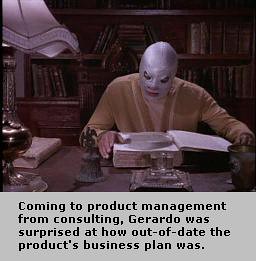My first PM book report

Sadly, if you were to line up the books about product management in the technology industry that are worth reading, you wouldn’t fill up a bookshelf. Not only are there too few books on the topic, but some of the ones you’ll find from a quick search on Amazon aren’t that good.
Therefore, when two good books on product management appear at roughly the same time, it’s time to celebrate an unexpected bumper crop. The first, The Product Manager’s Desk Reference by Steven Haines, does exactly what its title suggests: provide reference information that covers a gamut of PM tasks. The other, The Art Of Product Management by Rich Mironov, also covers a wide swath of the product management world–but in a somewhat different way.
Histories and biographies
Over the holiday, I read Overlord, Max Hastings’ history of the Normandy campaign in WWII. Like all good histories, it covers as much detail as it can without becoming unreadable. (Actually, Hastings is remarkably pithy, focusing often on aspects of the campaign that need reconsideration.) It’s the historical counterpart to Haines’ desk reference, a comprehensive look at a topic.
I’m sure many of you, Dear Readers, have watched the HBO mini-series Band Of Brothers, which provides a different look at the same set of events. Rather than being comprehensive, Band Of Brothers is painfully intimate and personal–and no less valid, or essential, in understanding the events of June 1944.
The personal perspective, which is closer to what Mironov’s The Art Of Product Management provides, has its limits. By following one company of paratroopers, Band Of Brothers doesn’t give you the widely varied experiences of other participants in the campaign, such as the bomber pilot flying over the flak-ridden skies of Normandy, the infantry struggling to gain a bloody foothold on Omaha Beach, or Eisenhower at SHAEF headquarters.

Still, you can’t afford to collect all these experiences, nor should you. For most purposes, a selective sampling of personal experiences is instructive enough.
Putting The Product Manager’s Desk Reference To The Test
Even a comprehensive view makes choices about what to present. At the beginning of The Product Managers’ Desk Reference, I already found signs that what the author describes as product management may not match exactly what product management means in many companies. (Hardly surprising, given the variability of product management across the industry.) Here is Haines’ answer to the question, "What is a product manager?"
- The product manager is a person appointed to be a proactive product or product line "mini-CEO" or general manager.
- The product manager leads a cross-functional team.
- The product team’s responsibility is to optimize the product’s market position and financial returns, consistent with corporate, business unit, or division strategies.
I’ve known PMs who definitely fit that profile–and many who don’t. For example, some PMs function more in a support role, handling tasks like collecting and interpreting requirements, instead of leading a cross-functional team. Some PMs are very business-focused, and others would be amazed to hear that they were responsible for forecasting, one of the job functions that Haines identifies immediately after this definition.
Still, nothing I’ve said here is really a criticism of Haines’ book. As a comprehensive guide to all the things product managers do, The Product Manager’s Desk Reference is a mirror in which all PMs will see themselves.
The real test of this sort of book is its ability to address a particular concern–the sort of thing that would compel you to reach for the hefty reference on the bookshelf. For example, what do you do when a new product seems to be based on some good ideas, but you’re not getting the sales and marketing traction you think it deserves? Here’s what I found in Haines’ book to help with that problem:
- In Chapter 8 ("Finding Markets To Conquer By Understanding Customer Needs And Market Segments"), a strategy for market-testing the product idea. Spotting the right market segment is the necessary first step–which, to be brutally honest, many companies don’t do, even well into multiple versions of a product.
- In Chapter 12 ("Is There Really A Business Here?"), a good checklist of what it takes to put together not just a new product, but a business (support, marketing, sales, etc.) around it.
- In Chapter 18 ("Auditing Results After The Launch"), some useful tips on what information you may have missed that will tell you why your particular product isn’t doing as well as it might.
There’s more in Haines’ book that can help, but we don’t need a complete list to know whether the Desk Reference is worth reaching for. It definitely is, for both neophyte PMs trying to learn the job, and veterans who need guidance on handling the challenge du jour.
One of the chief virtues of The Product Manager’s Desk Reference is its ability to identify the sorts of tasks you may not be doing, but should. The statement, "Every company does product management differently," should not be comforting. Although we’re a long way from making product management as standardized as other professions, it’s clear that, as companies improvise their way through product management, they often miss many core functions.
Unfortunately, you can’t wave The Product Manager’s Desk Reference at people whenever they’re not doing the right tasks as product managers, or they’re not using the services of product managers effectively. You need to look over the shoulders of successful product managers to understand life in the trenches–which is where Mironov’s The Art Of Product Management can be a critical resource.
[Since this post is pretty long, I’ll cover Mironov’s book in the next one.]